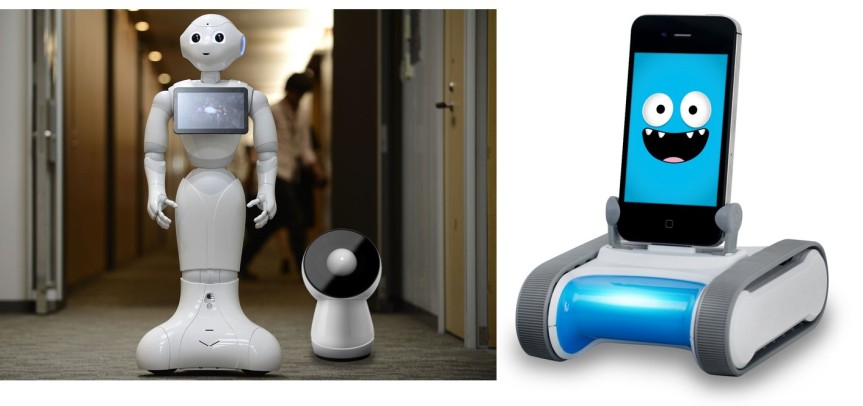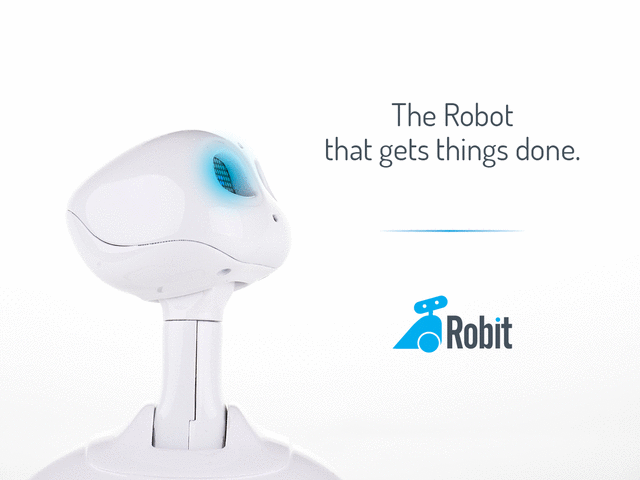The field of house robots is abuzz in the last two years. It began with Jibo – the first cheap house robot that was originally advertised on Indiegogo and gathered nearly $4 million. Jibo doesn’t look at all like Asimov’s vision of humanoid robots. Instead, it resembles a small cartoon-like version of Eve from the Wall-E movie. Jibo can understand voice commands, recognize and track faces, and even take pictures of family members and speak and interact with them. It can do all that for just $750 – which seems like a reasonable deal for a house robot. Romo is another house robot for just $150 or so, with a cute face and a quirky attitude, which has sadly gone out of production last year.

Now comes a new contender in the field of house robots: Robit, “The Robot That Gets Things Done”. It moves around the house on its three wheels, wakes you up in the morning, looks after lost items like your shoes or keys on the floor, detects smoke and room temperature, and even delivers beer for you on a tray. And it’s doing all that for just $349 on Indiegogo.

I interviewed Shlomo Schwarcz, co-founder & CEO at Robit Robot, about Robit and the present and future of house robots. Schwarcz emphasized that unlike Jibo, Robit is not supposed to be a ‘social robot’. You’re not supposed to talk with it or have a meaningful relationship with it. Instead, it is your personal servant around the house.
“You choose the app (guard the house, watch your pet, play a game, dance, track objects, find your list keys, etc.) and Robit does it. We believe people want a Robit that can perform useful things around the house rather than just chat.”
It’s an interesting choice, and it seems that other aspects of Robit conform to it. While Jibo and Romo are pleasant to look at, Robit’s appearance can be somewhat frightening, with a head that resembles that of a human baby. The question is, can Robit actually do everything promised in the campaign? Schwarcz mentions that Robit is essentially a mobile platform that runs apps, and the developers have created apps that cover the common and basic usages: remote control from a smartphone, movement and face detection, dance, and a “find my things” app.
Other, more sophisticated apps, will probably be left for 3rd parties. These will include Robit analyzing foodstuff and determining its nutritional value, launching toy missiles at items around the house using a tiny missile launcher, and keeping watch over your cat so that it doesn’t climb on that precious sofa that used to belong to your mother in law. These are all great ideas, but they still need to be developed by 3rd parties.
This is where the Robit both wins and fails at the same time. The developers realized that no robotic device in the near future is going to be a standalone achievement. They are all going to be connected together, learn from each other and share insights by means of a virtual app market that can be updated every second. When used that way, robots everywhere can evolve much more rapidly. And as Shwarcz says –
“…Our vision [is] that people will help train robots and robots will teach each other! Assuming all Robits are connected to the cloud, one person can teach a Robit to identify, say a can and this information can be shared in the cloud and other Robits can download it and become smarter. We call these bits of data “insights”. An insight can be identifying something, understanding a situation, a proper response to an event or even just an eye and face expression. Robots can teach each other, people will vote for insights and in short time they will simply turn themselves to become more and more intelligent.”
That’s an important vision for the future, and one that I fully agree with. The only problem is that it requires the creation of an app market for a device that is not yet out there on the market and in people’s houses. The iPhone app store was an overnight success because the device reached the hands of millions in the first year to its existence, and probably because it also was an organic continuation of the iTunes brand. At the moment, though, there is no similar app management system for robots, and certainly not enough robots out there to justify the creation of such a system.
At the moment, the Robit crowdfunding campaign is progressing slowly. I hope that Robit makes it through, since it’s an innovative idea for a house robot, and definitely has potential. Whether it succeeds or fails, the campaign mainly shows that the house robots concept is one that innovators worldwide are rapidly becoming attached to, and are trying to find the best ways to implement. In twenty years from now, we’ll laugh about all the whacky ideas these innovators had, but the best of those ideas – those that survived the test of time and market – will serve us in our houses. Seen from that aspect, Shwarcz is one of those countless unsung heroes: the ones who try to make a change in a market that nobody understands, and dare greatly.
Will he succeed? That’s for the future to decide.


I wonder if you can dedicate a post to Nick Bostrom’s session on “Evolution to AI will be more radical than ape-to-human” at AAAI-16?
LikeLike
I think Bostrom is completely right. I’ll try to write about it later. Thanks!
LikeLike